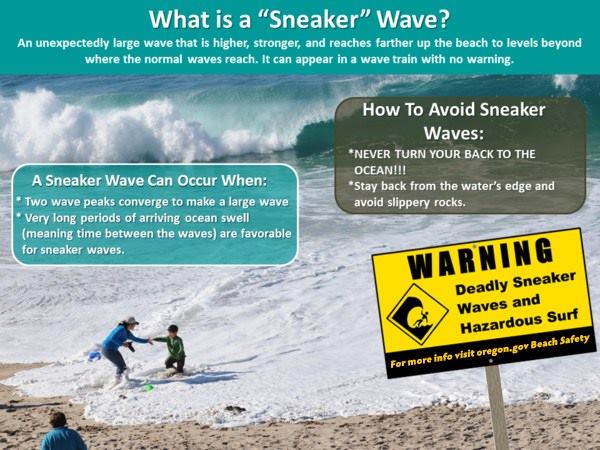Eight Ways to Stay Safe on the Beaches Along the Oregon Coast

Following these rules could possibly save your life (or someone else’s). PLEASE read and follow these guidelines for your safety and the safety of those around you.
It’s no secret that the Oregon Coast is a haven for those who love the outdoors. The sight and sounds of majestic Pacific Ocean waves crashing into rugged cliffs is a scene that draws thousands to our area each year. Our quiet, peaceful, undeveloped beaches ideal for long walks and tide-pooling are another feature that attracts curious nature lovers from all over the country to our region. Sadly, if one is not careful, what should be a peaceful day by the sea could suddenly turn deadly without warning.
Now that “storm watching season” is upon us, it’s more important than ever to avoid potential dangers by following these guidelines to keep you and your family safe on Oregon’s Adventure Coast. In addition to these guidelines, most state parks and public beaches will post rules and regulations that are very important to follow.
#1-Never Underestimate the Power and Danger of a Sneaker Wave.
Of all the potential hazards, the dangerous sneaker wave can be the most deadly because it is very powerful and comes without warning. Sneaker waves are characterized by a sudden and powerful surge of water that can easily knock you down and drag you into the ocean. Large waves can easily also wash over jetties and rock outcroppings that normally stay dry and protect beach goers. Watch what happens when Steve Raplee, the owner of the High Tide Cafe, was recording the scene at the beach when a sneaker wave came in, sending him and others scrambling for safety. (Video source: The Oregonian courtesy of Steve Raplee )
The best way to avoid being caught in a powerful and deadly sneaker wave is to never turn your back to the ocean and always keep your eyes on the water.

#2-Supervise children very closely.
Children are very adventurous and can quickly find themselves in dangerous situations along the coast if one is not careful. Be extra mindful of their whereabouts at all times and do not let them out of your sight when you are close to the ocean. We do not advise taking young children to the water’s edge during storms and other weather events that may make the ocean unpredictable and potentially dangerous. There are numerous spots where you can view the ocean from a safe distance listed at the end of this post.
We also advise keeping dogs on a leash when you’re close to the water. They too can be vulnerable to powerful sneaker waves and find themselves in danger in a flash.
#3-Avoid playing or standing on logs.
Our rustic and undeveloped beaches often contain mysterious and beautiful wood formations and logs. While it’s tempting to explore them, we advise that you avoid standing or sitting on them, especially if they are close to the water. Children should never play or climb on the logs. Any wave, regardless of its strength, is capable of lifting the log and can result in serious injury and even tragedy.
#4 -Beware of the steep cliffs.
High and steep cliffs may offer perfect vantage points for viewing the ocean, but be aware that these cliffs often contain sharp and slippery rocks. Make sure that you are wearing protective footgear when on cliffs and keep away from the edges of the cliffs.
#5 -Beware of the bases of cliffs.
Just like the edges, the bases of the cliffs are equally dangerous. You should mind your head when around such areas as parts of the soil can collapse and hit your head.
#7- Be Prepared & Be Smart.
Check the National Weather Service for any severe weather warnings issued along the coast. Wear appropriate foot gear (i.e. athletic shoes or hiking boots) in addition to weatherproof jackets and other attire you can layer to stay warm and protected. Avoid alcoholic drinks or any drug that will affect the normal functioning of the body. It’s always a good idea to let others know of your whereabouts, especially if you are traveling alone.
#8- Look for the safer areas to experience the coast.
If you are traveling with young children or animals, or just don’t want to risk it, there are a number of spots on Oregon’s Adventure Coast we can recommend for your safety. Shore Acres State Park has a designated viewing area just for ocean gazers and storm watchers offering magnificent views. On rainy days, there is a storm watching hut to keep visitors safe and dry. A few other great local storm watching spots include the bluff overlooking Bastendorff Beach and Sunset Bay State Park along Cape Arago Highway. Sunset Bay State Park also features a protected beach, with tide pools exposed at low tide. The beach is probably the safest beach to walk on in winter, due to its geography, with land on three sides and an island that slows incoming waves.
